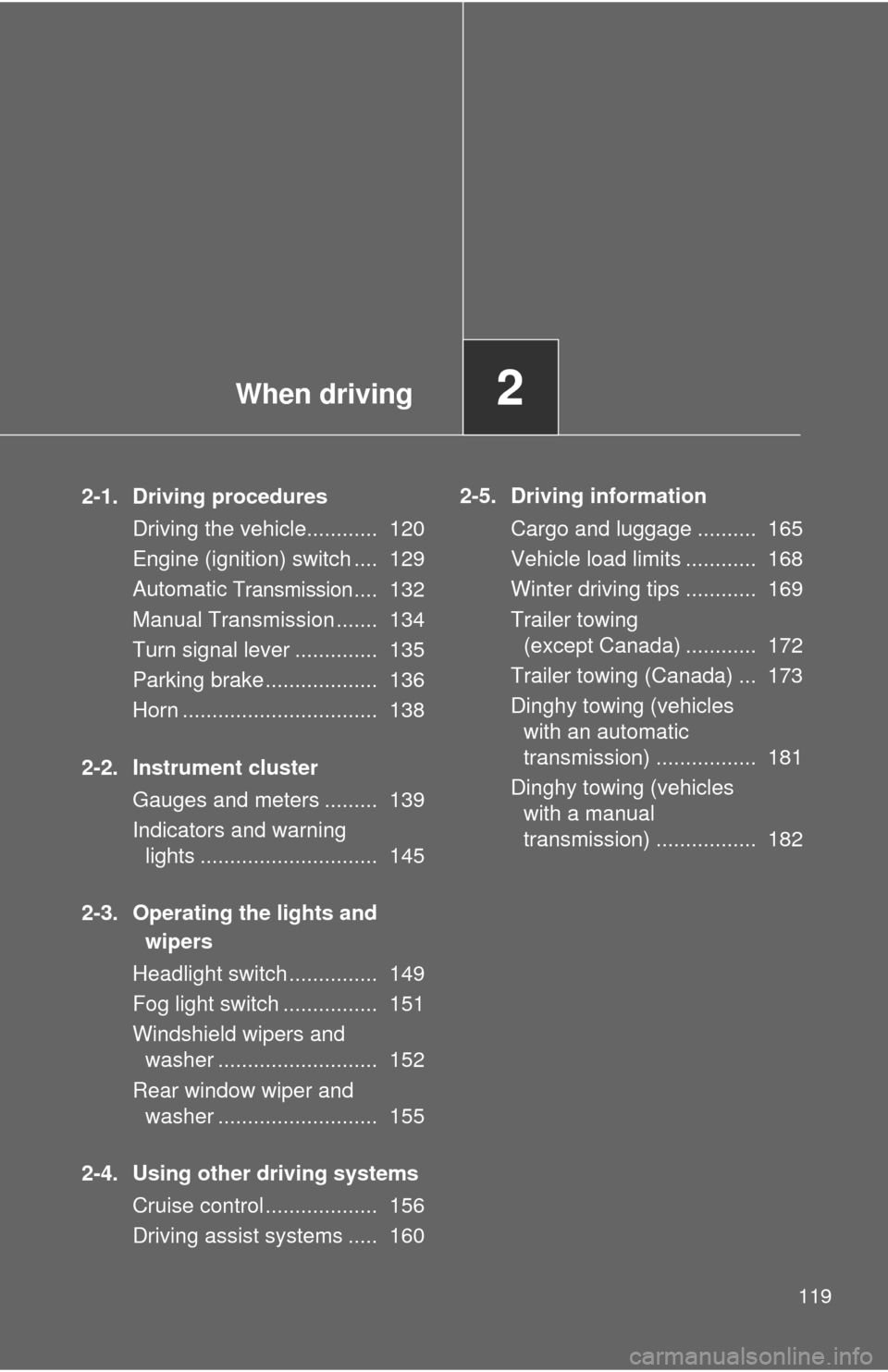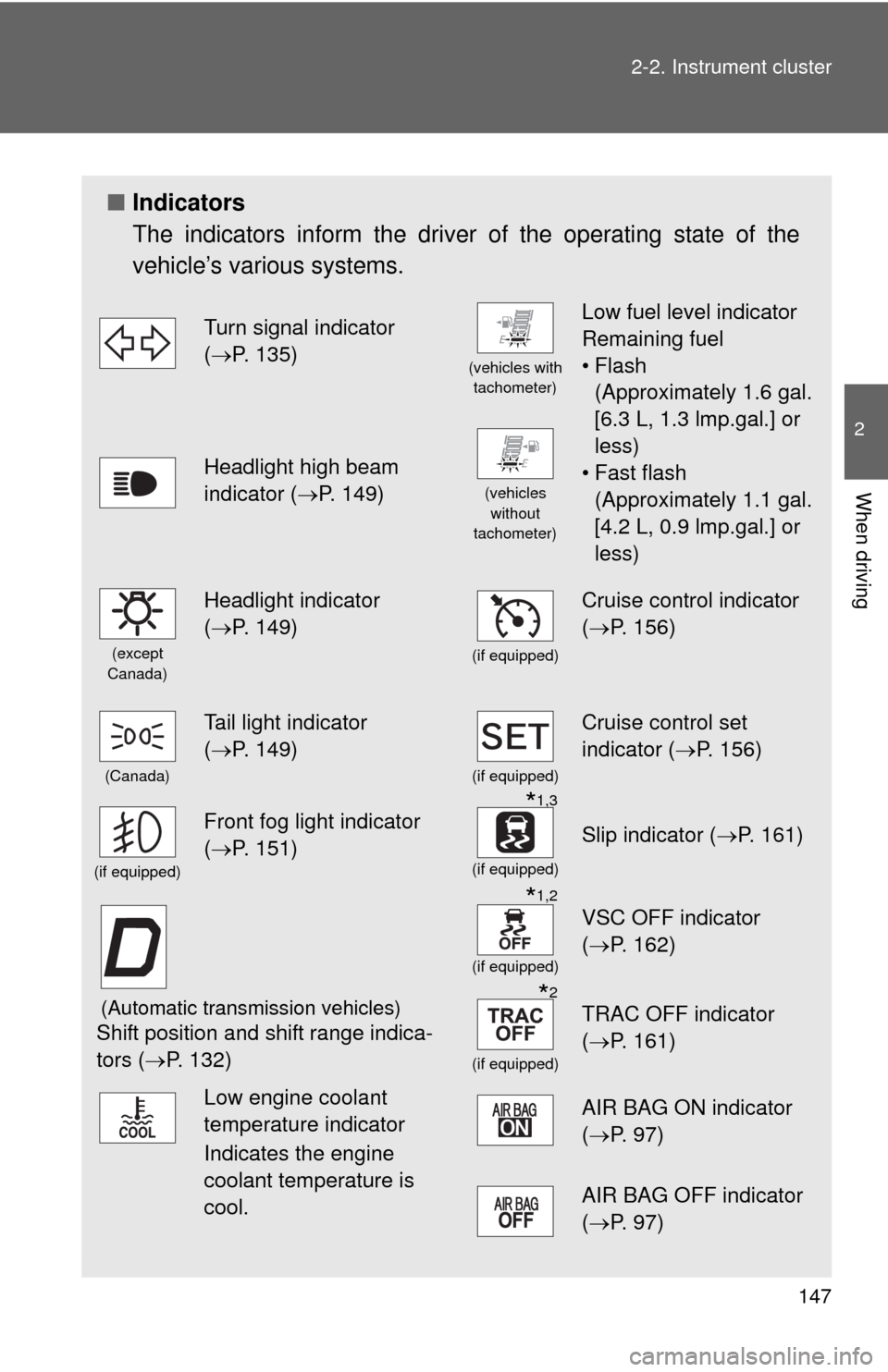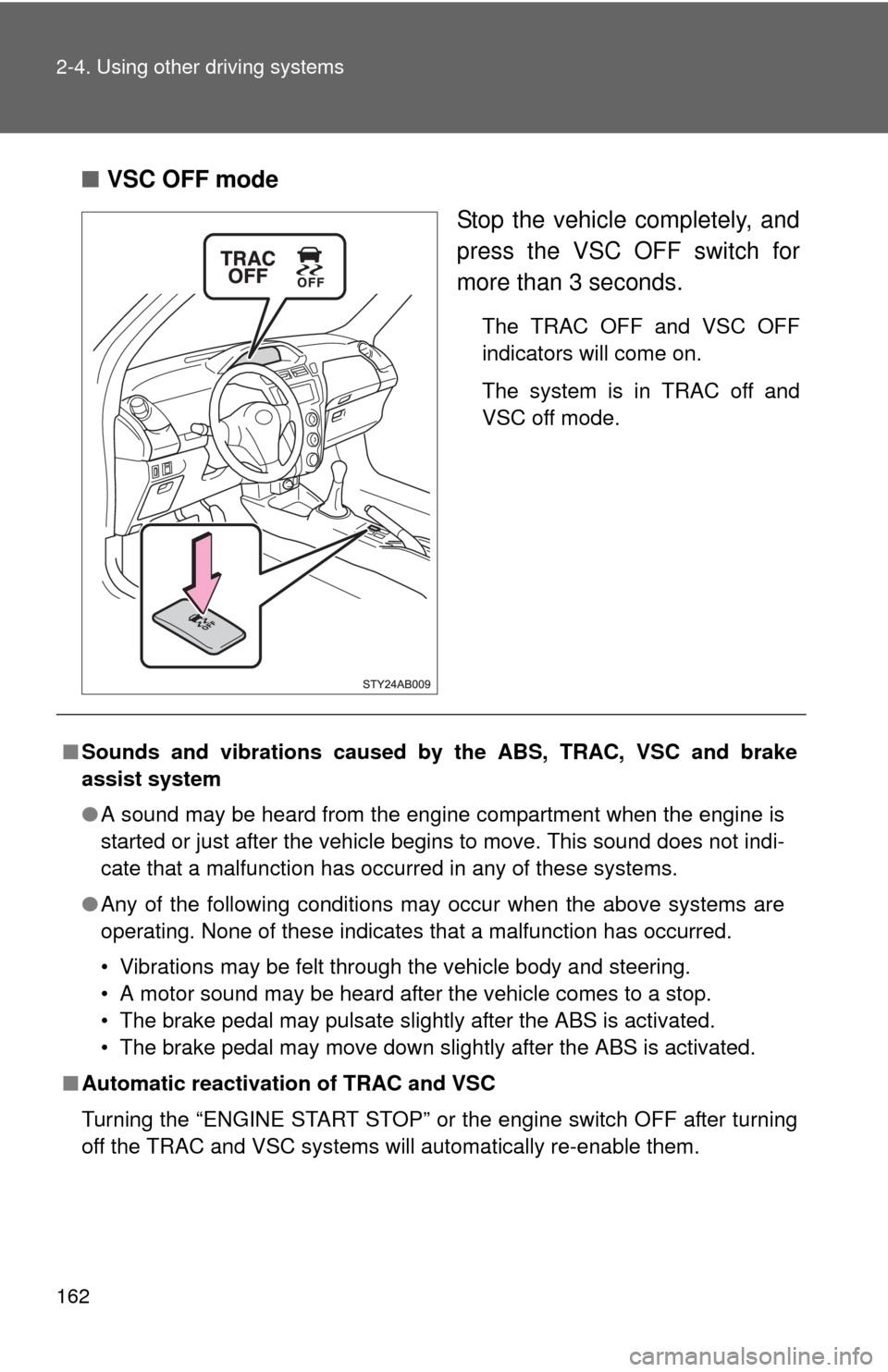Page 2 of 400

TABLE OF CONTENTSIndex
2
1-1. Key information
Keys ..................................... 26
1-2. Opening, closing and locking
the doors
Wireless remote control ....... 28
Side doors ............................ 31
Back door ............................. 36
1-3. Adjustable components
(seats, mirrors, steering
wheel)
Front seats ........................... 40
Rear seats ............................ 43
Head restraints ..................... 50
Seat belts ............................. 56
Steering wheel ..................... 66
Anti-glare inside rear view
mirror .................................. 67
Outside rear view mirrors ..... 68
1-4. Opening and closing the
windows
Power windows .................... 71
1-5. Refueling
Opening the fuel tank cap .... 74
1-6. Theft deterrent system
Engine immobilizer
system ................................ 78
Alarm (Puerto Rico).............. 80
Theft prevention labels
(except Canada) ................ 821-7. Safety information
Correct driving posture ......... 83
SRS airbags ......................... 85
Front passenger occupant
classification system ........... 97
Child restraint systems ....... 102
Installing child restraints ..... 106
2-1. Driving procedures
Driving the vehicle .............. 120
Engine (ignition) switch....... 129
Automatic
Transmission...... 132
Manual Transmission ......... 134
Turn signal lever ................. 135
Parking brake ..................... 136
Horn .................................... 138
2-2. Instrument cluster
Gauges and meters ............ 139
Indicators and warning
lights ................................. 145
2-3. Operating the lights and
wipers
Headlight switch ................. 149
Fog light switch ................... 151
Windshield wipers and
washer .............................. 152
Rear window wiper and
washer .............................. 155
2-4. Using other driving systems
Cruise control ..................... 156
Driving assist systems ........ 160
1Before driving
2When driving
Page 119 of 400

When driving2
119
2-1. Driving procedures
Driving the vehicle............ 120
Engine (ignition) switch .... 129
Automatic
Transmission.... 132
Manual Transmission ....... 134
Turn signal lever .............. 135
Parking brake ................... 136
Horn ................................. 138
2-2. Instrument cluster
Gauges and meters ......... 139
Indicators and warning
lights .............................. 145
2-3. Operating the lights and
wipers
Headlight switch ............... 149
Fog light switch ................ 151
Windshield wipers and
washer ........................... 152
Rear window wiper and
washer ........................... 155
2-4. Using other driving systems
Cruise control ................... 156
Driving assist systems ..... 1602-5. Driving information
Cargo and luggage .......... 165
Vehicle load limits ............ 168
Winter driving tips ............ 169
Trailer towing
(except Canada) ............ 172
Trailer towing (Canada) ... 173
Dinghy towing (vehicles
with an automatic
transmission) ................. 181
Dinghy towing (vehicles
with a manual
transmission) ................. 182
Page 128 of 400

128 2-1. Driving procedures
NOTICE
■Avoiding damage to vehicle parts
●Do not turn the steering wheel fully in either direction and hold it there for a
long time.
Doing so may damage the power steering motor.
●When driving over bumps in the road, drive as slowly as possible to avoid
damaging the wheels, underside of the vehicle, etc.
■If you hear a squealing or scraping noise while driving (brake pad wear
limit indicators)
Have the brake pads checked and replaced by your Toyota dealer as soon
as possible.
The rotor damage can result if the pads are not replaced when needed.
It is dangerous to drive the vehicle when the wear limits of the brake pads
and/or that of the brake discs are exceeded.
■If you get a flat tire while driving
A flat or damaged tire may cause the following situations. Hold the steering
wheel firmly and gradually press the brake pedal to slow down the vehicle.
●It may be difficult to control your vehicle.
●The vehicle will make abnormal sounds.
●The vehicle will behave abnormally.
Replace a flat tire with a new one. (P. 328)
■When encountering flooded roads
Do not drive on a road that has flooded after heavy rain etc. Doing so may
cause the following serious damage to the vehicle.
●Engine stalling
●Short in electrical components
●Engine damage caused by water immersion
In the event that you drive on a flooded road and the vehicle is flooded, be
sure to have your Toyota dealer check the following.
●Brake function
●Changes in quantity and quality of engine oil, transaxle fluid, etc.
●Lubricant condition for the bearings and suspension joints (where possi-
ble) and the function of all joints, bearings, etc.
Page 135 of 400
135
2-1. Driving procedures
2
When driving
Tur n signal lever
■Turn signals can be operated when
The engine switch is in the ON position.
■If the indicators flash faster than usual
Check that a light bulb in the front or rear turn signal lights has not burned
out.
Left turn
Right turn
Move and hold the lever
partway to signal a lane
change.
The left hand signal will flash
until you release the lever.
Move and hold the lever
partway to signal a lane
change.
The right hand signal will flash
until you release the lever.
Page 145 of 400
145
2-2. Instrument cluster
2
When driving
Indicators and warning lights
The indicator and warning lights on the instrument cluster and cen-
ter panel inform the driver of the status of the vehicle’s various sys-
tems.
Instrument cluster (vehicles with tachometer)
Instrument cluster (vehicles without tachometer)
Page 147 of 400

147 2-2. Instrument cluster
2
When driving
■Indicators
The indicators inform the driver of the operating state of the
vehicle’s various systems.
Turn signal indicator
(P. 135)
(vehicles with
tachometer)
Low fuel level indicator
Remaining fuel
•Flash
(Approximately 1.6 gal.
[6.3 L, 1.3 lmp.gal.] or
less)
• Fast flash
(Approximately 1.1 gal.
[4.2 L, 0.9 lmp.gal.] or
less)
Headlight high beam
indicator (P. 149)
(vehicles
without
tachometer)
(except
Canada)
Headlight indicator
(P. 149)
(if equipped)
Cruise control indicator
(P. 156)
(Canada)
Tail light indicator
(P. 149)
(if equipped)
Cruise control set
indicator (P. 156)
(if equipped)
Front fog light indicator
(P. 151)*1,3
(if equipped)
Slip indicator (P. 161)
(Automatic transmission vehicles)
Shift position and shift range indica-
tors (P. 132)
*1,2
(if equipped)
VSC OFF indicator
(P. 162)
*2
(if equipped)
TRAC OFF indicator
(P. 161)
Low engine coolant
temperature indicator
Indicates the engine
coolant temperature is
cool.AIR BAG ON indicator
(P. 97)
AIR BAG OFF indicator
(P. 97)
Page 162 of 400

162 2-4. Using other driving systems
■VSC OFF mode
Stop the vehicle completely, and
press the VSC OFF switch for
more than 3 seconds.
The TRAC OFF and VSC OFF
indicators will come on.
The system is in TRAC off and
VSC off mode.
■Sounds and vibrations caused by the ABS, TRAC, VSC and brake
assist system
●A sound may be heard from the engine compartment when the engine is
started or just after the vehicle begins to move. This sound does not indi-
cate that a malfunction has occurred in any of these systems.
●Any of the following conditions may occur when the above systems are
operating. None of these indicates that a malfunction has occurred.
• Vibrations may be felt through the vehicle body and steering.
• A motor sound may be heard after the vehicle comes to a stop.
• The brake pedal may pulsate slightly after the ABS is activated.
• The brake pedal may move down slightly after the ABS is activated.
■Automatic reactivation of TRAC and VSC
Turning the “ENGINE START STOP” or the engine switch OFF after turning
off the TRAC and VSC systems will automatically re-enable them.
Page 244 of 400
244 4-2. Maintenance
Vehicle interior
ItemsCheck points
Accelerator pedal• Moves smoothly (without uneven
pedal effort or catching)?
Automatic transmission “Park”
mechanism• Can the vehicle be hold securely
on an incline with the shift lever in
P?
Brake pedal• Moves smoothly?
• Does it have appropriate clear-
ance and correct amount of free
play?
Brakes• Not pull to one side when
applied?
• Loss of brake effectiveness?
• Spongy feeling brake pedal?
• Pedal almost touches floor?
Clutch pedal• Moves smoothly?
• Does it have correct amount of
free play?
Head restraints• Move smoothly and lock
securely?
Indicators/buzzers • Function properly?
Lights• Do all the lights come on?
• Headlights aimed correctly?
Parking brake• Moves smoothly?
• Can hold the vehicle securely on
an incline?
Seat belts• Does the seat belt system oper-
ate smoothly?
• Are the belts undamaged?
Seats• Do the seat controls operate
properly?